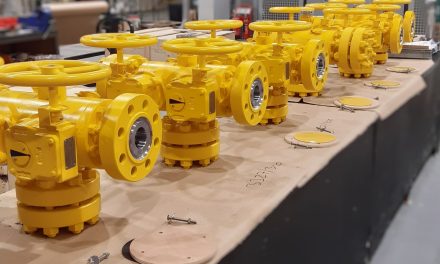 A Micropump supplied by Michael Smith Engineers has been specified to meet the complex demands of a specialist application in the manufacture of reinforced laminated double-glazed panel sections
A Micropump supplied by Michael Smith Engineers has been specified to meet the complex demands of a specialist application in the manufacture of reinforced laminated double-glazed panel sections
Today’s building design and architectural trends demand constant innovation in materials manufacture, which means suppliers are required to develop products which meet the challenges of cutting-edge design and energy efficiency. An example of this is specialist glass panels for cladding the outside of buildings to maximise light and heat, such as those manufactured by Specialist Glass Products (SGP).
Producing such glass is a specialised application which proved too challenging for a traditional mechanically sealed pump. However, Michael Smith Engineers has recently supplied a Micropump and inverter system to SGP, which has successfully met the complex demands of the application.
The process involves making reinforced laminated double-glazed panel sections varying in sizes up to 5m, with some of the panels needing to be curved. Glass panels with very low thermal conductivities are placed into specially designed mounts inclined at one end and then a second panel is suspended and lowered over the mounted panel. The edges are aligned and fixed spacers are inserted around the edges of the two panels, a sealing strip is then applied around all sides.
The interior ‘sandwich’ section is then filled with a pre-determined volume of UV sensitive urethane based acrylic monomer resin. This filling process is done by a batching pump, with total volume calculated via a batched metering system, with the flow rate also being adjusted during the process.
The flow rate adjustment is critical because the UV resin must be introduced between the two panels at exactly the right speed. If the flow is fractionally too fast the mixture picks up air bubbles. These bubbles take a long time to move up the glass panel before they can be burst and released at the open end of the panel, if they don’t, then the complete panel has to be scrapped.
Once an initial flow rate to the base of the panel is established and the base edge of the panel is confirmed as sealed, the flow rate is then gradually increased to ensure that no bubbles become entrained. The filling operators watch the flow of the resin and adjust the feed rate to the maximum possible in order to reduce manufacturing time. As the filling process nears completion, the flow is reduced to ensure an even spread of the resin in the top of the panel. The top edge is then sealed and overhead UV lamps cure the resin for 20 minutes up to a few hours, depending on the size and thickness of the panel.
The key elements of Michael Smith Engineers’ design brief were; provide a pumping system which would deliver a smooth, even and accurate output to reduce the chance of entrained bubbles, incorporate a sealless magnet coupling so resin will not be exposed to air causing it to harden in the pump, ease-of-use for the operator and automatic slowing down of the pump at the end of the batch to prevent overfilling. Specifically, the need was for a pumped batch metering transfer system for acrylic monomer resin with a viscosity of 100cP. This was designed to draw the resin from the 1000l IBC at a flow rate of between 0.1 to 1.2l/min in metered batch sizes of 0.1 to 10l with stop, start and resume controls.
The system comprises a Micropump with an inverter controlled motor with integral dual channel encoder for operating at speeds up to 2100 RPM. Following installation and operation the pumping system’s filling accuracy was measured at +/-1% of batched volume and thanks to the smooth and accurate delivery of the resin combined with optimum speed control, the problems of entrained bubbles were eliminated. A second system has subsequently been supplied to batch meter a similar acrylic monomer resin, but with a viscosity of 0.8 to 2 cP.
The successful use of the Micropump in this application is a good example of its characteristics, which allow users to specify a pump which is tailored specifically to their application. The range comprises 9 series of pumps covering flow rates from as low as ml/hr, up to 40 l/min at maximum discharge pressures between 5.2 and 8.5 bar, depending on the model and the fluid. They are available in a choice of metallurgies including stainless steel and Hastelloy, while a range of different gear materials can be specified to best suit the liquid being pumped and/or the duty parameters. They can also be supplied with different porting arrangements.
Michael Smith Engineers
T: 0800 316 7891


